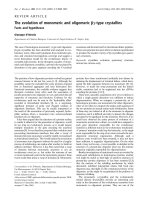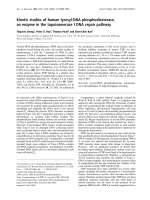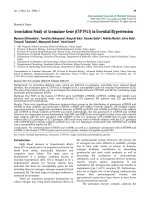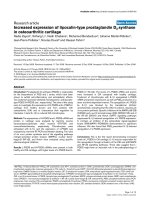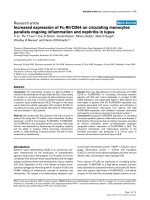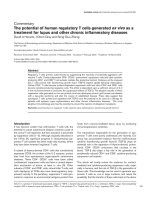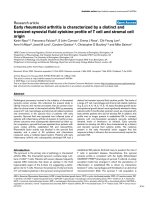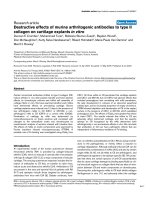Báo cáo y học: " Increased production of viral proteins by a 3''''-LTR-deleted infectious clone of human T-cell leukemia virus type 1" ppsx
Bạn đang xem bản rút gọn của tài liệu. Xem và tải ngay bản đầy đủ của tài liệu tại đây (348.99 KB, 5 trang )
BioMed Central
Page 1 of 5
(page number not for citation purposes)
Virology Journal
Open Access
Short report
Increased production of viral proteins by a 3'-LTR-deleted infectious
clone of human T-cell leukemia virus type 1
Takeo Ohsugi
Address: Division of Microbiology and Genetics, Center for Animal Resources and Development, Institute of Resource Development and Analysis,
Kumamoto University, 2-2-1 Honjo, Kumamoto 860-0811, Japan
Email: Takeo Ohsugi -
Abstract
We previously reported that a full-length provirus of HTLV-1 was directly constructed from the
HTLV-1-transformed cell line MT-2 using overlapping polymerase chain reaction (PCR) and cloned
into a plasmid vector (pFL-MT2). 293T cells transfected with pFL-MT2 alone did not produce virus
particles because there was no expression of the viral transactivator protein Tax, whereas cells
transfected with pFL-MT2 plus a Tax expression vector produced virus-like particles. In the
process of constructing the HTLV-1 provirus by overlapping PCR, we also constructed an
incomplete molecular clone, in which the 3' long terminal repeat (LTR) was replaced with the
endogenous human gene, which resulted in the expression of a tax gene shorter by 43 bp. This
incomplete molecular clone alone expressed Tax and produced the viral protein in transfected
cells. Various clones were then constructed with different lengths of the 3' LTR and lacking the
reverse-direction TATA box. The clones contained over 113 bp of the 3' LTR, with no reverse-
direction TATA box, which might express the full-length tax gene, and did not produce the viral
antigen. These results suggest that Tax in which the C-terminal portion is deleted is more strongly
expressed than the wild-type protein and has transcriptional activity.
Findings
Human T-cell leukemia virus type 1 (HTLV-1) was the first
human retrovirus to be isolated [1,2]. It causes an aggres-
sive malignancy known as adult T-cell leukemia/lym-
phoma, as well as inflammatory diseases such as HTLV-1-
associated myelopathy/tropical spastic paraparesis, after a
very prolonged period of latency, often lasting between 20
and 50 years [3,4]. The tax gene product encoded by the
pX region of HTLV-1 appears to be a key element in the
development of HTLV-1-associated diseases [5-7]. Tax
enhances productive virus replication by driving gene
transcription via the cAMP-responsive element located in
the viral long terminal repeat (LTR) [8,9]. Tax also acti-
vates the expression of many cellular genes, including
genes that encode cytokines, cytokine receptors, and
immediate early transcription factors, via the activation of
several cellular signal transduction pathways, such as the
nuclear factor kappaB (NF-κB) and serum response factor
(SRF) pathways [10-12].
The generation of infectious viruses from cloned proviral
DNA is one of the best ways to investigate the biology and
pathogenicity of viruses, and to improve methods of dis-
ease control. We previously constructed an infectious
molecular clone using overlapping polymerase chain
reaction (PCR) [13]. 293T cells transfected with this clone
alone did not produce virus-like particles, whereas cells
transfected with this clone plus a Tax expression vector
produced viral-like particles. These cells were then used to
produce virus-like particles that were capable of infecting
Published: 24 December 2009
Virology Journal 2009, 6:229 doi:10.1186/1743-422X-6-229
Received: 23 October 2009
Accepted: 24 December 2009
This article is available from: />© 2009 Ohsugi; licensee BioMed Central Ltd.
This is an Open Access article distributed under the terms of the Creative Commons Attribution License ( />),
which permits unrestricted use, distribution, and reproduction in any medium, provided the original work is properly cited.
Virology Journal 2009, 6:229 />Page 2 of 5
(page number not for citation purposes)
a human T-cell line. In constructing the HTLV-1 provirus
by overlapping PCR, we sometimes isolated an incom-
plete provirus with a deletion in the 3' LTR. To construct
the full-length clone, four fragments were constructed by
PCR: 1.4-kb 5LTR-gag(-), 3.9-kb gag(+)-pol(-), 2.7-kb
pol(+)-SK44, and 1.7-kb SK43-3LTR. The full-length
HTLV-1 DNA (9 kb) was synthesized from these four DNA
fragments using overlapping PCR. It was sometimes
found that the 1.7-kb SK43-3LTR fragment was replaced
with the human chromosome 14 DNA sequence during
the overlapping PCR process. Therefore, a 3'-LTR-deleted
HTLV-1 molecular clone was constructed (Figure 1A). The
constructed full-length (pFL-MT2) and 3'-LTR-deleted
clones were used to transfect the human epithelial 293T
cell line. Transfections of 293T cells were performed as
described previously [13]. Viral antigens were detected in
the supernatants of cells transfected with these clones
using an enzyme-linked immunosorbent assay (ELISA)
[13]. Surprisingly, the 3'-LTR-deleted clone produced viral
antigen when the clone alone was transfected into 293T
cells, whereas 293T cells transfected with the complete
HTLV-1 proviral DNA alone did not produce viral antigen
(Figure 1B). To increase the plasmid replication in trans-
fected cells, the SV40 origin of replication (ori) was added
to these clones but the viral antigen expression levels did
not increase in all the clones. Next, tax gene expression
was confirmed in the cells transfected with the clones
using reverse transcription (RT)-PCR [14]. 293T cells
transfected with the complete proviral DNA did not
express the tax gene, whereas 293T cells transfected with
the 3'-LTR-deleted clone expressed the tax gene (Figure
1C).
Next, to confirm the region of the 3' LTR responsible for
the increase in viral replication, various clones were con-
structed with different lengths of the 3' LTR (Figure 2A). A
BstEII site was found in the replacement sequence
(human chromosome 14 DNA; 1256 bp) of the Δ3' LTR,
and removed 1169 bp from the Δ3' LTR. The recon-
structed clone had 39 bp of the 3' LTR and 87 bp of
human chromosome 14 DNA, and was designated Δ3'
LTR BstEII. Δ3' LTR SacI was constructed by removing a
272-bp fragment downstream from the SacI site of the 3'
LTR in the complete molecular clone pFL-MT2. Δ3' LTR
AatII was constructed by removing a 643-bp fragment
downstream from the AatII site of the 3' LTR in the com-
plete molecular clone pFL-MT2 and contained 113 bp of
the 3' LTR. The complete HTLV-1 provirus has the same
LTR at its 5' and 3' ends. The HTLV-1 LTR has a reverse-
direction TATA box [15]. Therefore, to investigate whether
the transcripts derived from the reverse direction inhibit
HTLV-1 replication, a Δreverse TATA mutant, was con-
structed by site-specific PCR mutagenesis (GeneTailor™,
Invitrogen, Carlsbad, CA, USA), and contained a deletion
of the reverse TATA sequence, but with no change in the
amino acid sequence of Tax.
These constructed clones were used to transfect the
human epithelial 293T cell line. RT-PCR of the transfected
293T cells with Δ3' LTR and Δ3' LTR BstEII demonstrated
that the cells expressed mRNA sequences corresponding
to the tax gene. However, the cells transfected with other
Δ3' LTR clones, including the complete provirus, did not
express the tax gene (Figure 2B). The expression of other
HTLV-1 genes (gag, pol, and env) was the same as that of
the tax gene (data not shown). The Δreverse TATA mutant
did not produce the viral antigen. Recently, the expression
of the HTLV-1 basic leucine zipper factor (HBZ), an anti-
sense mRNA transcribed from the 3' LTR, has been shown
to be consistently expressed in adult T-cell leukemia cells.
Thus, HBZ may have a functional role in cellular transfor-
mation and leukemogenesis [16]. HBZ was first found to
inhibit the Tax-mediated transactivation of viral transcrip-
tion from the 5' LTR by heterodimerizing with Jun and
CREB2 [17]. None of the constructed Δ3' LTR clones con-
tained the promoter for the HBZ gene located in U5 and
only the part R region of the 3' LTR [18]. No HBZ gene
transcript was detected by RT-PCR in cells transfected with
any clone, including those transfected with the complete
provirus clone.
These results suggest that the sequence between 40 nucle-
otides (nt) and 113 nt at the Aat
II site downstream from
the beginning of the 3' LTR, which constitutes the C-ter-
minal portion of the tax downstream sequence, might be
involved in the inhibition of the replication of HTLV-1
genes in infectious molecular clones. It is suggested that
the complete infectious molecular clone could not pro-
duce the viral antigen because the expression of Tax was
low, and there might exist a binding site for cellular fac-
tors that inhibit the expression of the tax gene between 40
nt and 113 nt at the AatII site downstream from the begin-
ning of the 3' LTR. Recently, Fryrear et al. reported that a
Tax mutant (353 amino acids), in which the C-terminal
portion (amino acids 323-353) was deleted, displayed
higher transcriptional activity than that of the wild-type
protein [19]. There is a PDZ-protein-binding motif at this
site, which interacts with several PDZ proteins, such as
DLG1, the precursor of interleukin 16, and MAGI3 [20-
25]. Ishioka et al. reported that inactivation of DLG1 aug-
ments the Tax-mediated transformation of cells. This find-
ing suggests that DLG1 regulates the function of Tax
through its PDZ-binding motif [26]. HTLV-1-infected cells
in the peripheral blood rarely express viral genes in HTLV-
1-infected individuals [16,27]. This might be caused by
cellular factors, such as PDZ proteins, inhibiting Tax
expression by binding to the PDZ-protein-binding motif
in the C-terminal portion of the tax gene.
Virology Journal 2009, 6:229 />Page 3 of 5
(page number not for citation purposes)
Increased expression of viral antigens in 293T cells transfected with an HTLV-1 clone with a deleted 3' LTRFigure 1
Increased expression of viral antigens in 293T cells transfected with an HTLV-1 clone with a deleted 3' LTR. (A)
Molecular clones of HTLV-1 constructed by overlapping PCR. The complete genome, pFL-MT2 (upper), and a 3'-LTR-deleted
clone in which the 3' LTR was replaced with that of the endogenous human gene (lower). (B) Increased expression of the p19
gag protein was detected by ELISA after transfection with the 3'-LTR-deleted clone. The amount of p19 gag in the concen-
trated (200-fold) medium from cells transfected with the complete molecular clone, pFL-MT2, pFL-MT2 + SV40 ori, Δ3' LTR,
or Δ3' LTR + SV40 ori. (C) RT-PCR detection of the doubly spliced tax mRNA in cells transfected with the complete molecular
clone or with the Δ3' LTR clone 2-3 days after transfection or with pUC19 two days after transfection. MT-2, total RNA
extracted from the HTLV-1-infected cell line MT-2 was used as the positive control; N, total RNA extracted from 293T cells
was used as the negative control.
'
'
'
Virology Journal 2009, 6:229 />Page 4 of 5
(page number not for citation purposes)
Various molecular clones with deletions of the 3' LTR of different lengths and the corresponding viral expression patternsFigure 2
Various molecular clones with deletions of the 3' LTR of different lengths and the corresponding viral expres-
sion patterns. (A) Diagram of the molecular clones showing the deletion series of the 3' LTR and the deletion of the reverse
TATA box of the 3' LTR. (B) The amount of p19 gag in the pooled concentrated (100-fold) medium from 293T cells trans-
fected with the complete molecular clone pFL-MT2 or with clones containing deletions of the 3' LTR of different lengths and
the deleted reverse TATA box 2-3 days after transfection. The results of RT-PCR detection of tax mRNA in cells transfected
with the various clones are shown on the left side.
'
'
'
'
'
'
'
'
'
'
'
Publish with Bio Med Central and every
scientist can read your work free of charge
"BioMed Central will be the most significant development for
disseminating the results of biomedical research in our lifetime."
Sir Paul Nurse, Cancer Research UK
Your research papers will be:
available free of charge to the entire biomedical community
peer reviewed and published immediately upon acceptance
cited in PubMed and archived on PubMed Central
yours — you keep the copyright
Submit your manuscript here:
/>BioMedcentral
Virology Journal 2009, 6:229 />Page 5 of 5
(page number not for citation purposes)
Competing interests
The author declares that they have no competing interests.
Acknowledgements
This work was supported in part by a Grant-in-Aid for Scientific Research
from the Japan Society for the Promotion of Science, the Japan Leukaemia
Research Fund, and Kumamoto University's Centers of Excellence (COE)
Program.
References
1. Hinuma Y, Nagata K, Hanaoka M, Nakai M, Matsumoto T, Kinoshita
KI, Shirakawa S, Miyoshi I: Adult T-cell leukemia: antigen in an
ATL cell line and detection of antibodies to the antigen in
human sera. Proc Natl Acad Sci USA 1981, 78:6476-6480.
2. Poiesz BJ, Ruscetti FW, Gazdar AF, Bunn PA, Minna JD, Gallo RC:
Detection and isolation of type C retrovirus particles from
fresh and cultured lymphocytes of a patient with cutaneous
T-cell lymphoma. Proc Natl Acad Sci USA 1980, 77:7415-7419.
3. Uchiyama T: Human T cell leukemia virus type I (HTLV-I) and
human diseases. Annu Rev Immunol 1997, 15:15-37.
4. Watanabe T: HTLV-1-associated diseases. Int J Hematol 1997,
66:257-278.
5. Jeang KT, Giam CZ, Majone F, Aboud M: Life, death, and tax: role
of HTLV-I oncoprotein in genetic instability and cellular
transformation. J Biol Chem 2004, 279:31991-31994.
6. Ohsugi T, Koito A: Current topics in prevention of human T-
cell leukemia virus type i infection: NF-kappa B inhibitors
and APOBEC3. Int Rev Immunol 2008, 27:225-253.
7. Yoshida M: Multiple viral strategies of HTLV-1 for dysregula-
tion of cell growth control. Annu Rev Immunol 2001, 19:475-496.
8. Brady J, Jeang KT, Duvall J, Khoury G: Identification of p40x-
responsive regulatory sequences within the human T-cell
leukemia virus type I long terminal repeat. J Virol 1987,
61:2175-2181.
9. Jeang KT, Boros I, Brady J, Radonovich M, Khoury G: Characteriza-
tion of cellular factors that interact with the human T-cell
leukemia virus type I p40x-responsive 21-base-pair
sequence. J Virol 1988, 62:4499-4509.
10. Jeang KT: Functional activities of the human T-cell leukemia
virus type I Tax oncoprotein: cellular signaling through NF-
kappa B. Cytokine Growth Factor Rev 2001, 12:207-217.
11. Sun SC, Yamaoka S: Activation of NF-kappaB by HTLV-I and
implications for cell transformation. Oncogene 2005,
24:5952-5964.
12. Winter HY, Marriott SJ: Human T-cell leukemia virus type 1
Tax enhances serum response factor DNA binding and alters
site selection. J Virol 2007, 81:6089-6098.
13. Ohsugi T, Kumasaka T, Urano T: Construction of a full-length
human T cell leukemia virus type I genome from MT-2 cells
containing multiple defective proviruses using overlapping
polymerase chain reaction. Anal Biochem 2004, 329:281-288.
14. Ohsugi T: Activation of a cryptic splice site in the tax gene of
HTLV-I by a single nucleotide change. Biochimie 2006,
88:147-150.
15. Larocca D, Chao LA, Seto MH, Brunck TK: Human T-cell leuke-
mia virus minus strand transcription in infected T-cells. Bio-
chem Biophys Res Commun 1989, 163:1006-1013.
16. Matsuoka M, Jeang KT: Human T-cell leukaemia virus type 1
(HTLV-1) infectivity and cellular transformation. Nat Rev Can-
cer 2007, 7:270-280.
17. Gaudray G, Gachon F, Basbous J, Biard-Piechaczyk M, Devaux C,
Mesnard JM: The complementary strand of the human T-cell
leukemia virus type 1 RNA genome encodes a bZIP tran-
scription factor that down-regulates viral transcription. J
Virol 2002, 76:12813-12822.
18. Satou Y, Yasunaga J, Yoshida M, Matsuoka M: HTLV-I basic leucine
zipper factor gene mRNA supports proliferation of adult T
cell leukemia cells. Proc Natl Acad Sci USA 2006, 103:720-725.
19. Fryrear KA, Durkin SS, Gupta SK, Tiedebohl JB, Semmes OJ: Dimer-
ization and a novel Tax speckled structure localization signal
are required for Tax nuclear localization. J Virol 2009,
83:5339-5352.
20. Hirata A, Higuchi M, Niinuma A, Ohashi M, Fukushi M, Oie M, Aki-
yama T, Tanaka Y, Gejyo F, Fujii M: PDZ domain-binding motif of
human T-cell leukemia virus type 1 Tax oncoprotein aug-
ments the transforming activity in a rat fibroblast cell line.
Virology 2004, 318:
327-336.
21. Kiyono T, Hiraiwa A, Fujita M, Hayashi Y, Akiyama T, Ishibashi M:
Binding of high-risk human papillomavirus E6 oncoproteins
to the human homologue of the Drosophila discs large
tumor suppressor protein. Proc Natl Acad Sci USA 1997,
94:11612-11616.
22. Ohashi M, Sakurai M, Higuchi M, Mori N, Fukushi M, Oie M, Coffey
RJ, Yoshiura K, Tanaka Y, Uchiyama M, Hatanaka M, Fujii M: Human
T-cell leukemia virus type 1 Tax oncoprotein induces and
interacts with a multi-PDZ domain protein, MAGI-3. Virology
2004, 320:52-62.
23. Rousset R, Fabre S, Desbois C, Bantignies F, Jalinot P: The C-termi-
nus of the HTLV-1 Tax oncoprotein mediates interaction
with the PDZ domain of cellular proteins. Oncogene 1998,
16:643-654.
24. Suzuki T, Ohsugi Y, Uchida-Toita M, Akiyama T, Yoshida M: Tax
oncoprotein of HTLV-1 binds to the human homologue of
Drosophila discs large tumor suppressor protein, hDLG, and
perturbs its function in cell growth control. Oncogene 1999,
18:5967-5972.
25. Wilson KC, Center DM, Cruikshank WW, Zhang Y: Binding of
HTLV-1 tax oncoprotein to the precursor of interleukin-16,
a T cell PDZ domain-containing protein. Virology 2003,
306:60-67.
26. Ishioka K, Higuchi M, Takahashi M, Yoshida S, Oie M, Tanaka Y, Taka-
hashi S, Xie L, Green PL, Fujii M: Inactivation of tumor suppres-
sor Dlg1 augments transformation of a T-cell line induced by
human T-cell leukemia virus type 1 Tax protein. Retrovirology
2006, 3:71.
27. Furukawa Y, Osame M, Kubota R, Tara M, Yoshida M: Human T-
cell leukemia virus type-1 (HTLV-1) Tax is expressed at the
same level in infected cells of HTLV-1-associated myelopa-
thy or tropical spastic paraparesis patients as in asympto-
matic carriers but at a lower level in adult T-cell leukemia
cells. Blood 1995, 85:1865-1870.


